Unless you’re using a slip joint or a friction folder, your pocket knife has a lock. But can you make a hard determination about which mechanism is the best pocket knife lock? Let’s take a look into some of the more common mechanisms and see where they are – and aren’t – the best.
Liner Locks
Nowadays, liner locks are probably the most common lock type among pocket knives. They consist of a small metal liner, in between the scales and frame of the knife, that is held under pressure when the knife is closed and springs open when the blade is deployed, locking it open.
Liner locks typically engage very easily (especially by the aid of thumb holes or a thumb stud), and can also be disengaged very easily with one hand. However, despite their conveniences, some of them can accidentally disengage when a lot of force is applied to the knife handle, or when the user torques or twists the locked-open handle.
Another thing to remember is that although it is easy to disengage and fold the blade with one hand, the user’s hand will be in the path of the blade when disengaging the lock, and so care must be taken.
Frame Locks
A frame lock is sort of like a liner lock, except instead of a piece of the liner locking the blade open, a portion of the frame swings inward when the blade is opened to lock it in place. Generally speaking, frame locks have all of the advantages of liner locks but few if any of their drawbacks.
Like liner locks, frame locks are very easy to deploy, engage and disengage with one hand. They are, however, typically much stronger since most framelocks have larger and thicker springs of steel that lock the blade open. You might think it would be too easy to accidentally disengage the blade, but this is not the case.
Frame locks are stronger than liner locks, but like them, a user’s hand will be in the path of the blade when closing the knife, so care should be taken when closing the blade.
Lock Backs
A lock back knife has a blade that is held closed under tension, which can be opened and locked into place via the action of a spring bar that fits into a notch on the back of the blade. This is a relatively old style of locking technology, introduced by the Buck 110 Folding Hunter, way back when.
They’re still pretty common on folding pocket knives, and for most purposes, they’re stronger than both liner locks and framelocks. However, a common complaint about folding knives with a lockback mechanism is that it takes two hands not only to open the knife but to disengage the lock and to close it. However, this does keep the user’s hands away from the blade’s path.
Collar Locks (AKA Ring Locks)
Collar locks are actually not common, and if you see a folding knife with one, it’s probably an Opinel. They’re not as strong as the other lock types on this list, but they are convenient and easy to engage and disengage
There are two basic advantages to this type of lock. One is that the mechanism is far easier to maintain and clean than the other locks mentioned here. The other is that these collars can usually be removed, transforming the knife into a non-locking version necessary for legal compliance in areas where locking folders are prohibited.
Learn More at White Mountain Knives
If you’re interested in learning more about these and other (there are many other) types of locking mechanisms, you can find out more online at White Mountain Knives. In their blog, you can read up on favorite knife models, knife terminology and much more.
Plus, their online shop has one of the largest inventories of knives on the internet. Whether you’re looking for a basic drop point model with a stainless steel blade for cutting rope and other basic chores, or a high tech EDC knife with a super steel for superior edge retention, a bottle opener and a four way reversible pocket clip, they have it. You just need to find it – check out their website today. The best pocket knife awaits you, you just need to find it.












